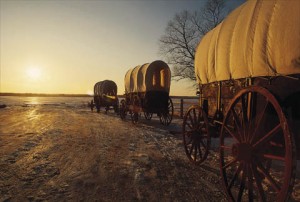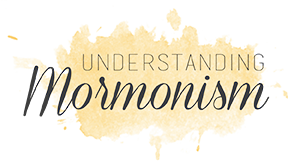Mormon Pioneers
In 1846, members of The Church of Jesus Christ of Latter-day Saints, Mormon Pioneers, were driven from their homes in Nauvoo, Illinois. They spent the winter in Nebraska, and the first company left with Brigham Young as their leader in the spring of 1847. They arrived in the Salt Lake Valley on July 24, 1847. The trip took them over 1,000 miles of unsettled land.Mormon pioneers traveled by wagon, horse, and even handcart. Between 1847 and 1869 more than 70,000 people crossed the plains to get to Salt Lake City. In 1869 the transcontinental railroad was completed, and while many more saints continued to gather in Utah, the Mormon Trail was no longer used.
President Gordon B. Hinckley said of the Mormon pioneers,
 “Those pioneers who broke the sunbaked soil of the Mountain West valleys came for one reason only-”to find,” as Brigham Young is reported to have said, “a place where the devil can’t come and dig us out.” They found it, and against almost overwhelming adversities they subdued it. They cultivated and beautified it for themselves. And with inspired vision they planned and built a foundation that blesses members throughout the world today” (lds.org).
“Those pioneers who broke the sunbaked soil of the Mountain West valleys came for one reason only-”to find,” as Brigham Young is reported to have said, “a place where the devil can’t come and dig us out.” They found it, and against almost overwhelming adversities they subdued it. They cultivated and beautified it for themselves. And with inspired vision they planned and built a foundation that blesses members throughout the world today” (lds.org).
These early Mormon pioneers had deep faith and strongly believed in the Mormon Church, so much that they were willing to travel to an unsettled desert so that they could live their religion without persecution.
Eliza R. Snow, a prominent woman in the early history of the Church, wrote of the conditions women faced on the trail:
As we journeyed, mothers gave birth to offspring under almost every variety of circumstances; except those to which they had been accustomed–in tents and wagons–in rainstorms and in snow storms. Let it be remembered that the mothers referred to, were not . . . accustomed to roam the forest and brave the storm and tempest . . . Most of them were born and educated in the Eastern States-[had] embraced the Gospel as taught by Jesus and His Apostles, and for its sake had gathered with the Saints; and under trying circumstances, assisted by their faith, energies and patience, [and made] Nauvoo what its name indicates, ‘The beautiful.’ There they had lovely homes-decorated with flowers, and enriched with choice fruit trees, just beginning to yield plentifully. To these homes, without lease or sale, they had bid a final adieu, and, with what little of their substance could be packed into one, two, and perhaps in a few instances, three wagons, had started out desert-ward, for where? To this question, the only response at that time was, God knows (Leon R. Hartshorn, comp., Remarkable Stories from the Lives of Latter-day Saint Women, vol. 1, p. 216).
The Mormon pioneers were probably among the most organized overland travelers. President Brigham Young had the people organized into companies of hundreds, fifties and tens, each with a captain. Individuals traveling alone, especially women without husbands and children without fathers were adopted into other families for the journey. Everyone in the company was given an assignment and felt a part of the company’s higher purpose. The pioneers worked to improve the roads, build bridges and shelters, and plant crops for those who would follow.
Traveling fifteen miles in a day was considered good, and members of the companies usually gathered together after setting up camp to enjoy music, singing, and dancing. One person who encountered many Mormon pioneers recorded, “In every Mormon train there are usually some musicians, for they seem to be very fond of song and dance, and as soon as the camp work is done the younger element gather in groups and ‘trip the light fantastic toe’ with as much vim as if they had not had a twenty mile march that day”
(lds.org).
